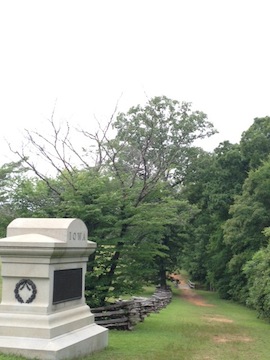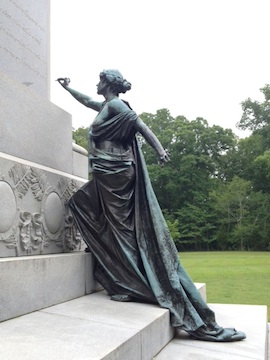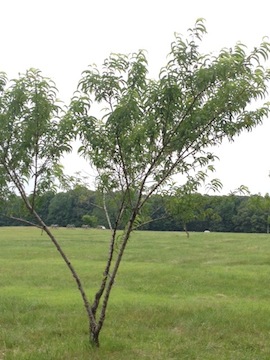Day Five: Shiloh
The swhrrrr of cicadas rises and falls like the heartbeat of the battlefield. I stand on the edge of Shiloh’s peach orchard, gazing through the trees at nothing in particular in the far distance. There’s a line of cannon over there, but I’m not really looking at them, specifically.
Not far, Dan and Steph have both walked over to Bloody Pond, both feeling reflective.
In fact, the entire Shiloh battlefield seems custom made for reflection.
Shiloh might well be the perfect battlefield. It’s plentitude of monuments makes if feel like a battlefield without feeling overwhelming. Aluminum War Department signs offer orientation and explanation, and wayside panels at the tour stops offer interpretation—enhance by an effective map in the park brochure.
 Best of all is Shiloh’s pristine nature. The closest town, Savannah, is eleven miles away, so it’s hardly ready to encroach on the battlefield with its cookie-cutter subdivisions and suburbs. The closest thing is a catfish restaurant on the edge of the battlefield, where we had a great dinner the night before.
Best of all is Shiloh’s pristine nature. The closest town, Savannah, is eleven miles away, so it’s hardly ready to encroach on the battlefield with its cookie-cutter subdivisions and suburbs. The closest thing is a catfish restaurant on the edge of the battlefield, where we had a great dinner the night before.
Established in 1894 under the purview of the War Department, Shiloh was turned over the Park Service in 1933. It’s one of the oldest—and best preserved—battlefields. It consists of nearly 4,000 acres of forests and fields.
We each find out own place for solace and reflection over the course of the day. For Dan, the best spot turns out to be the Bloody Pond. “With so many horrific scenes playing out around them, whether they wore the blue and the gray, so many men came here for comfort,” Dan says. “They drank and washed their wounds. The water turned red.”
 For Steph, it’s the Sunken Road along the Hornet’s Nest. She lingers there well after Dan and I are done taking photos. When I ask her how she liked it, she smiles a little and just nods.
For Steph, it’s the Sunken Road along the Hornet’s Nest. She lingers there well after Dan and I are done taking photos. When I ask her how she liked it, she smiles a little and just nods.
For me, it’s the Iowa monument not far from the visitor center. Years ago, when I made my first visit to the battlefield, the statue made a profound impact on me. I’ve been able to visit the monument only one other time since, so I’ve been looking forward to a return visit to Shiloh so I can spend some intentional time with it.
A large multi-tiered pedestal supports a tall pillar, with a bronze eagle perched atop. But what particularly captivates me is the statue, “Fame,” that stands on the monument’s steps and reaches up, so carefully, to inscribe the memories of the men on the granite. To me, this is the perfect manifestation of my own Civil War Muse, remembering Civil War stories. She’s so graceful as she writes, so ephemeral.
 Dan, Steph, and I also spend some time by the river’s edge at Pittsburg Landing, watching the river flow northward, right to left. Every few minutes, a catfish makes the surface of the water boil as it snatches at a meal. The quiet, quick splash is the only sound we hear as we stand on the riverbank until, from the far side, we hear the insistent lowing of cattle. “Noisy cows,” Steph says.
Dan, Steph, and I also spend some time by the river’s edge at Pittsburg Landing, watching the river flow northward, right to left. Every few minutes, a catfish makes the surface of the water boil as it snatches at a meal. The quiet, quick splash is the only sound we hear as we stand on the riverbank until, from the far side, we hear the insistent lowing of cattle. “Noisy cows,” Steph says.
Above the river, Shiloh National Cemetery overlooks the landing. Some 3,584 Union soldiers are buried there (as well as two Confederate POWs). As we walk through the cemetery, we stop by the three cannon barrels pyramided together at the spot of Ulysses S. Grant’s former headquarters. After the first day’s battle, his men had been nearly driven into the river.
“We’ve had the devil to pay,” his subordinate, William T. Sherman said to him that night.
“Lick ‘em tomorrow,” Grant replied.
And he did. His morning counterattacks, after being reinforced overnight, overwhelmed unsuspecting Confederates, who fell back all the way to Corinth, Mississippi.
The battle was unprecedented in its slaughter—23,746 casualties. More men died in the battle than in all other American wars combined to that point. Sherman, who’d predicted a long, bloody war—and who’d been labeled “crazy” for his prediction—must have felt an unfortunate vindication.
My friend and mentor, Greg Mertz, is working on a Shiloh book for the Emerging Civil War Series, which is why we’re here photographing the battlefield today. As a Boy Scout growing up in St. Louis, just a couple hours to the north, Greg grew up on the battlefield. It was his first Civil War love. I look forward to seeing this battlefield through his eyes.
I can see why he loves this place. I have fallen in love with it, too. Although I don’t get to visit often, when I do, I have found it a profound experience. It is everything I would to find on a battlefield, including a little bit of myself.

Shiloh is quite a place. Most of the monuments there are outdoor art as much as site markings, and show a depth of feeling I’ve not seen elsewhere.
I’ve done some in depth study of Shiloh over the years, tracking McClernand’s five battle lines and the like. My appreciation of the place grew slowly at first. While the field is indeed outstanding, for years I thought that it didn’t have much to contribute towards my own specific interests in weapons and tactics. I’ve come to realize that is incorrect.
I hope Greg will put to rest, once and for all, what occurred with Lew Wallace.